40 Beginner Gardening Ideas for Easy Success
Starting your garden with easy-to-grow vegetables like radishes and zucchini can lead to quick success. Choose a sunny spot with quality soil and consider using raised beds for drainage. Plan your layout for accessibility and aesthetics, and don’t forget to incorporate shade-loving plants where needed. Hosting a garden party or swap can boost your community engagement. Stay patient, and as you nurture your plants, you’ll discover even more effective tips to enhance your gardening journey.
Start With Easy-To-Grow Vegetables
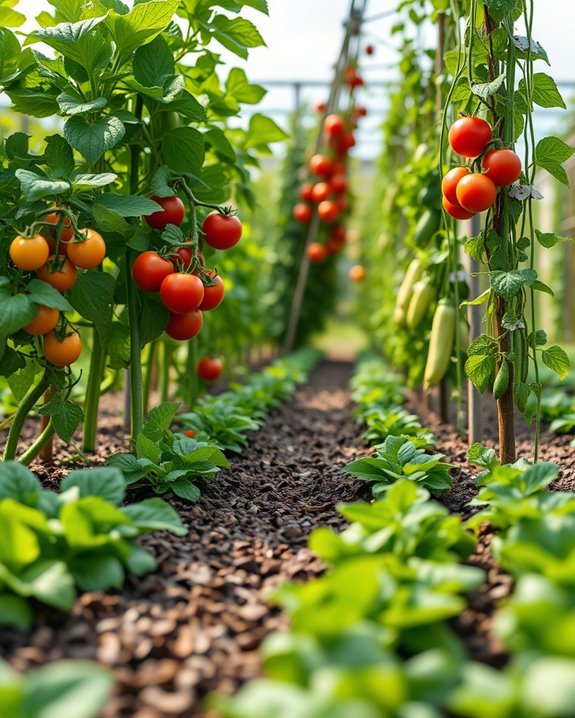
When you’re just starting out in gardening, choosing easy-to-grow vegetables can make the experience enjoyable and rewarding.
Consider planting easy vegetable varieties like radishes, lettuce, and zucchini. These require minimal care and grow quickly, giving you a sense of accomplishment.
Follow beginner gardening tips, such as using well-drained soil and consistent watering, to guarantee your plants thrive and flourish.
Choose the Right Location for Your Garden

Choosing the right location for your garden is essential for its success, as it directly impacts your plants’ growth.
Make sure you select a spot with ample sun exposure and good soil drainage, away from nearby trees that may block sunlight.
Consider wind protection, proximity to water sources, and accessibility paths for easy maintenance.
Also, think about garden aesthetics and how seasonal changes affect your space.
Invest in Quality Soil
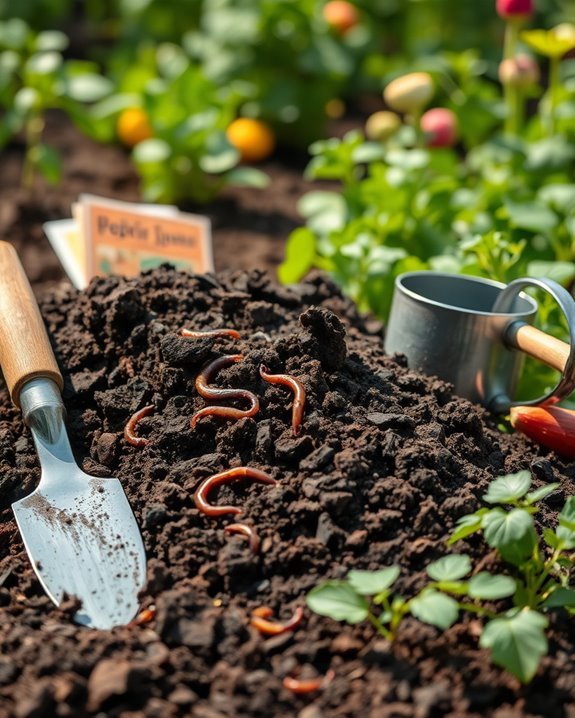
Soil is the foundation of your garden’s success, and investing in quality soil can make a significant difference in plant health and productivity.
Start by understanding different soil types and how they affect your plants. Consider soil testing to determine pH and nutrient levels, ensuring you provide the best environment for growth.
Quality soil leads to thriving plants and a rewarding gardening experience.
Use Raised Garden Beds

Quality soil sets the stage for a thriving garden, and using raised garden beds can further enhance your planting experience.
With soil elevation, you improve drainage and warmth, creating ideal conditions for your plants.
Plus, these beds act as effective pest barriers, keeping unwanted critters away.
You’ll find gardening easier and more rewarding, ultimately leading to a flourishing, productive garden.
Plan Your Garden Layout

Planning your garden layout is essential for maximizing both space and productivity.
Start with a clear garden design that considers sunlight, access, and plant height. Sketch your layout, grouping similar plants together and leaving room for walking paths.
Effective layout planning helps prevent overcrowding and guarantees your plants thrive.
Incorporate Companion Planting
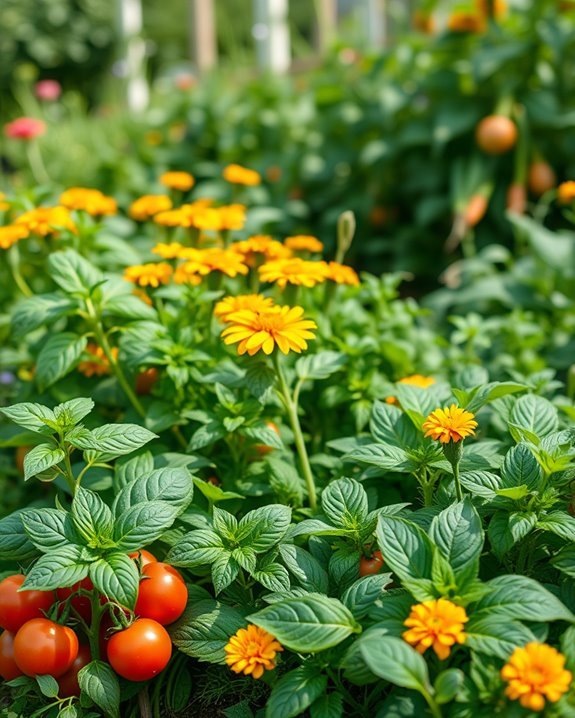
When you incorporate companion planting into your garden, you can boost growth and deter pests naturally.
By pairing plants like tomatoes with basil, you’ll enjoy companion planting benefits such as improved flavor and reduced bug issues.
Other successful companion plant pairings include carrots with onions, which help repel pests.
Discover which combinations work best for your space, and watch your garden thrive!
Try Container Gardening

If you’re short on space or want to add a pop of greenery to your porch or patio, container gardening is a fantastic option.
You can use decorative pots to showcase vibrant flowers or herb containers to grow fresh basil, mint, or rosemary.
This method allows you to easily manage your plants while enhancing your outdoor space’s beauty and functionality.
Utilize Vertical Gardening Techniques

While many gardeners face limited space, utilizing vertical gardening techniques can transform even the smallest areas into lush, green retreats.
Consider installing trellis systems for climbing plants, using wall gardens and garden walls to maximize vertical space.
Incorporate hanging planters and vertical planters on plant shelves or ladder gardens for creative, space-saving solutions that bring beauty and functionality to your garden.
Select Low-Maintenance Perennials

Maximizing your garden space doesn’t just involve clever layouts; it also means choosing the right plants.
Select low-maintenance perennials that offer shade tolerance, drought resistance, and pest resistance. Look for those with various foliage textures and seasonal blooms to attract pollinators.
Ascertain they fit your soil compatibility and growth habit, and enjoy a colorful garden with minimal maintenance requirements.
Grow Herbs for Culinary Use
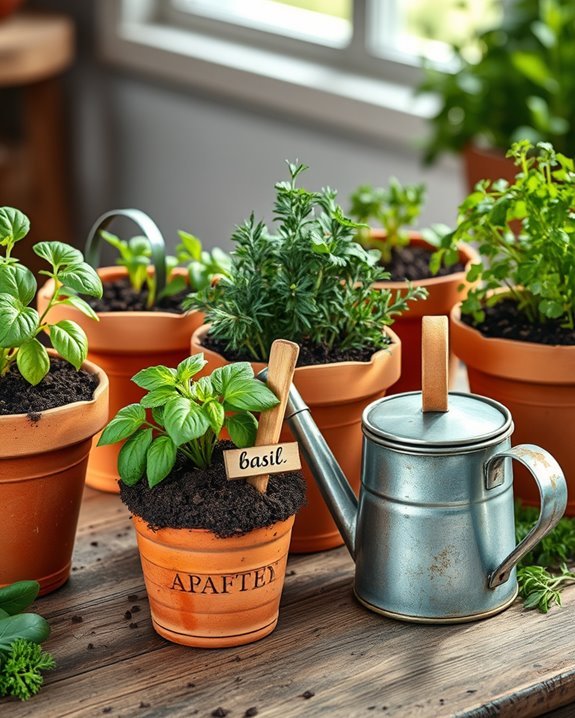
Growing herbs for culinary use not only enhances your dishes but also adds a vibrant touch to your garden.
You can easily grow various herb varieties like basil, parsley, and cilantro outdoors or as indoor herbs on a sunny windowsill.
Regularly snipping fresh herbs boosts their growth and keeps your meals flavorful, making this an enjoyable and rewarding gardening experience.
Experiment With Succession Planting

If you want to make the most of your garden space, experimenting with succession planting can be a game-changer.
By carefully planning your seasonal timing, you can maximize crop diversity and guarantee a continuous harvest.
Start with fast-growing crops like radishes or lettuce, then follow with slower ones like tomatoes.
This not only optimizes your space but also keeps your garden productive throughout the year.
Use Mulch to Retain Moisture

After you’ve planned your succession planting, maintaining moisture in your garden becomes key to ensuring those crops thrive.
Using mulch greatly enhances moisture retention, keeping your soil damp and reducing evaporation.
Plus, mulch benefits your garden by suppressing weeds and regulating soil temperature.
Water Wisely With Drip Irrigation
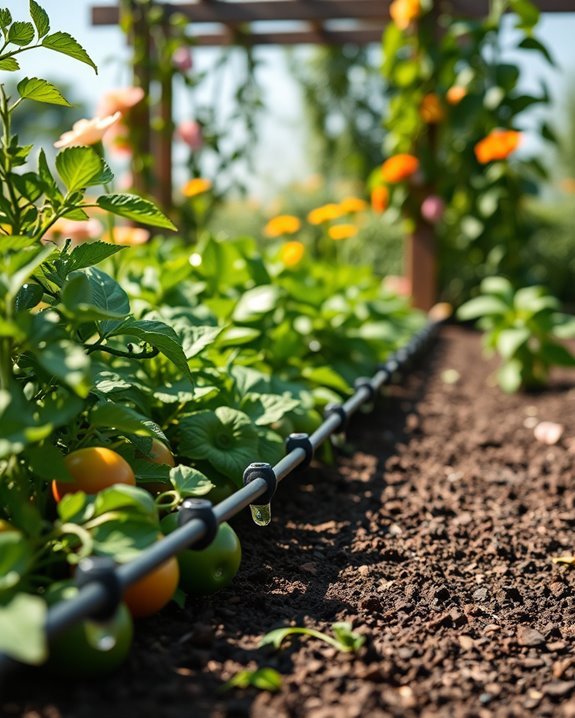
To guarantee your plants receive just the right amount of water, consider installing a drip irrigation system.
This method offers numerous drip system benefits, such as delivering water directly to the roots, reducing evaporation and runoff.
Plus, it’s an excellent way to implement water conservation techniques, ensuring you use less water while keeping your garden thriving.
Your plants will thank you!
Understand Sunlight Requirements

Understanding your plants’ sunlight requirements is key to a successful garden.
Different plants thrive under various sunlight exposure, so pay attention to their needs.
Observe your garden orientation to determine how much sunlight each area receives throughout the day.
This way, you can place sun-loving plants in brighter spots and shade-tolerant ones in less sunny locations, ensuring healthy growth and vibrant blooms.
Start a Compost Bin

Starting a compost bin can be one of the most rewarding steps in your gardening journey.
By collecting kitchen scraps like fruit peels and vegetable trimmings, you’ll create nutrient-rich compost that enriches your soil.
The compost benefits include improved plant growth and reduced waste in landfills.
It’s an easy way to contribute to a healthier garden and environment.
Start composting today!
Attract Pollinators With Flowers
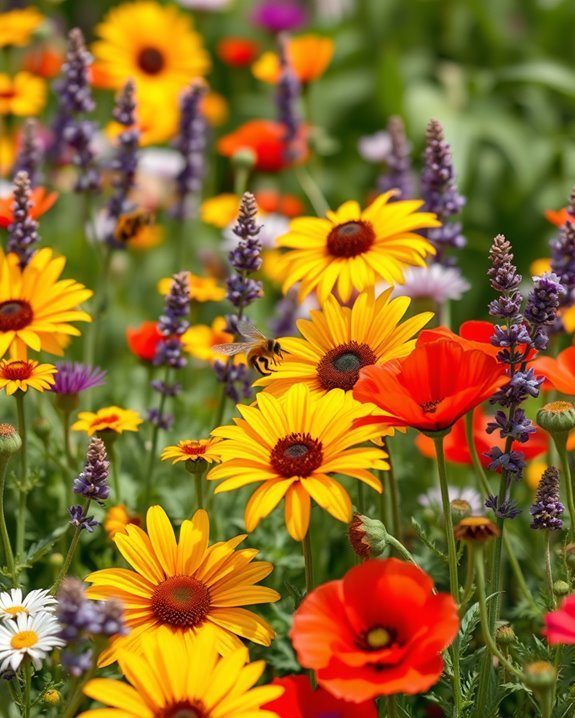
Creating a compost bin not only enriches your soil but also sets the stage for a thriving ecosystem in your garden.
To attract pollinators, plant diverse flower varieties, including bee-friendly flowers and nectar-rich plants. Incorporate colorful petals and seasonal blooms to enhance garden aesthetics.
These elements create butterfly habitats, providing a beautiful and inviting space for essential pollinators.
Learn Pest Management Strategies

Pest management is essential for maintaining a healthy garden and protecting your plants from unwanted invaders.
Start with pest identification to understand your challenges. Use organic pesticides and beneficial insects to control pests naturally.
Implement crop rotation and companion plants for diversity.
Employ insect traps and pheromone traps as preventive measures, and enhance habitats with cultural practices to keep your garden thriving.
Explore Indoor Gardening Options
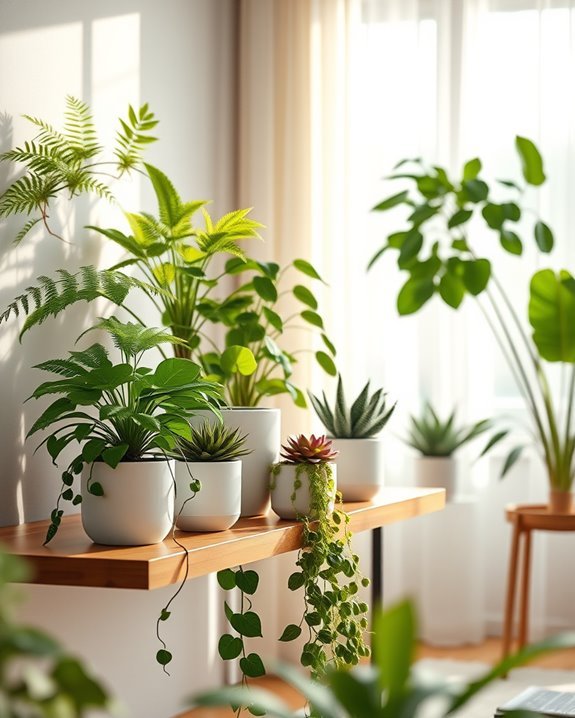
After managing pests outdoors, you might find yourself keen to bring some greenery inside.
Consider growing indoor herbs and vegetables in decorative pots or container plants. Use grow lights for ideal growth and focus on moisture control.
Indoor succulents can add charm while providing air purification.
With thoughtful plant care and creative arrangements, you’ll enjoy a vibrant indoor garden.
Utilize Seed Starting Indoors
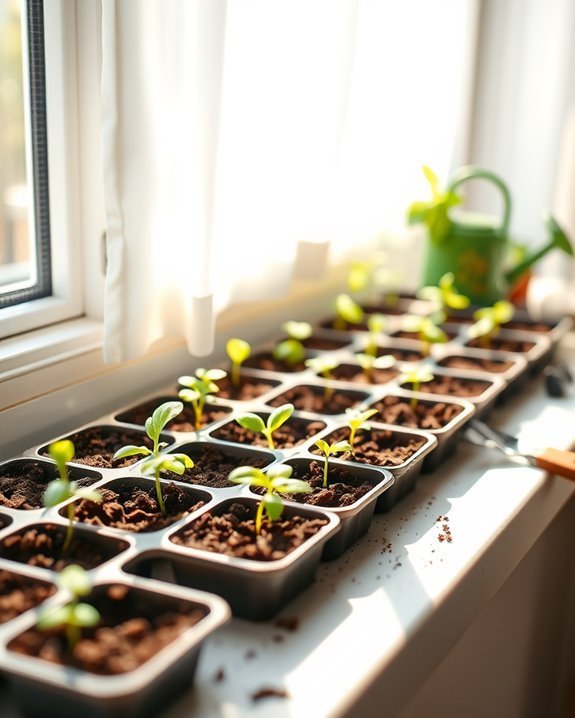
If you want to jumpstart your gardening adventure, utilizing seed starting indoors is a fantastic option.
Start with proper seed selection, choosing varieties that thrive indoors.
Make sure you provide adequate indoor lighting, using grow lights if natural light is limited.
This way, your seedlings will get the energy they need to grow strong and healthy, setting you up for gardening success.
Consider Native Plants for Your Area

As you nurture your seedlings indoors, think about expanding your garden with native plants that thrive in your local environment.
These plants offer numerous native plant benefits, such as requiring less water and maintenance.
Plus, they support local biodiversity by attracting pollinators and other wildlife.
Create a Garden Journal
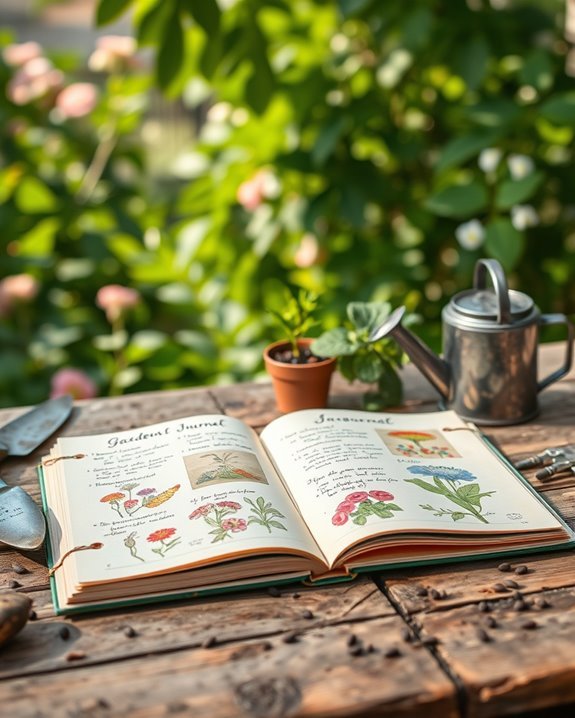
Starting a garden journal can be one of the most rewarding steps you take as a gardener. Document your garden layout, noting where each plant variety thrives or struggles.
Include observations on growth patterns, weather conditions, and pest issues. This valuable resource helps you make informed decisions for future seasons, ensuring your gardening journey becomes more successful and enjoyable over time.
Join a Community Gardening Group

Taking the next step in your gardening journey can be incredibly rewarding, and joining a community gardening group is a fantastic way to enhance your experience.
You’ll connect with fellow gardeners, participate in community events, and gain access to valuable gardening workshops.
Sharing tips and experiences with others not only improves your skills but also makes gardening more enjoyable and fulfilling.
Implement Crop Rotation
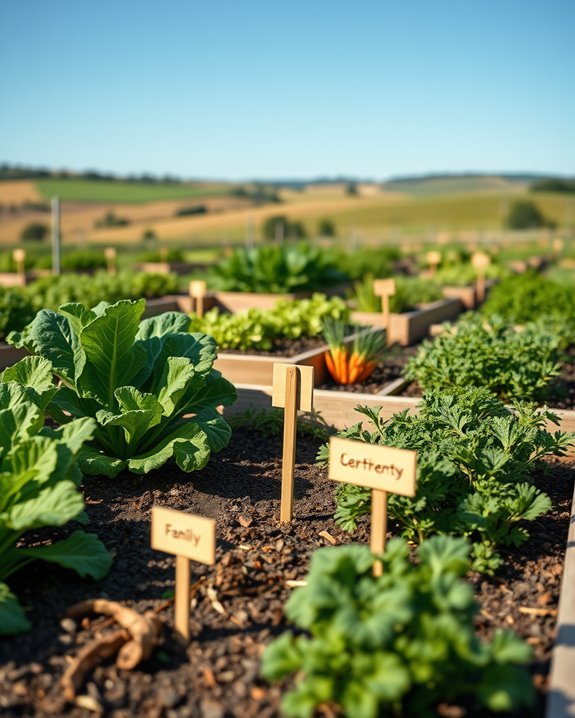
Implementing crop rotation can greatly improve your garden’s health and productivity.
By changing the types of crops you plant each season, you promote crop diversity, which helps prevent pests and diseases. This practice enhances soil health by allowing nutrients to replenish naturally.
Rotate legumes, leafy greens, and root vegetables to maximize benefits, ensuring your garden thrives year after year.
Practice Organic Gardening Methods

If you want to cultivate a thriving garden, practicing organic gardening methods is essential.
You can start by using organic pest control techniques, like introducing beneficial insects or using natural repellents.
Additionally, brewing compost tea enriches your soil with nutrients and beneficial microorganisms.
These methods not only promote plant health but also create a sustainable environment for your garden to flourish.
Use Natural Fertilizers
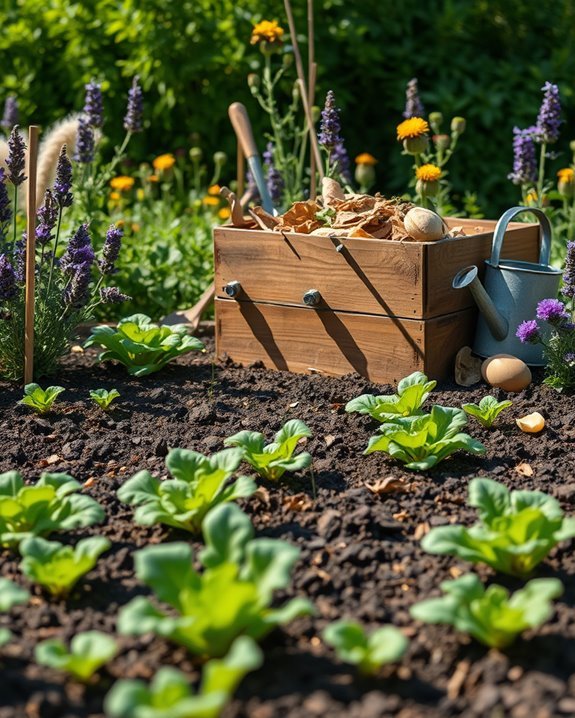
While chemical fertilizers may promise quick results, using natural fertilizers is a more sustainable choice for your garden.
You can explore various organic fertilizer options like bone meal or fish emulsion.
Additionally, embrace natural composting techniques by recycling kitchen scraps and yard waste.
These methods enrich your soil, promote healthy plant growth, and contribute to a thriving ecosystem in your backyard.
Grow Microgreens for Quick Harvests
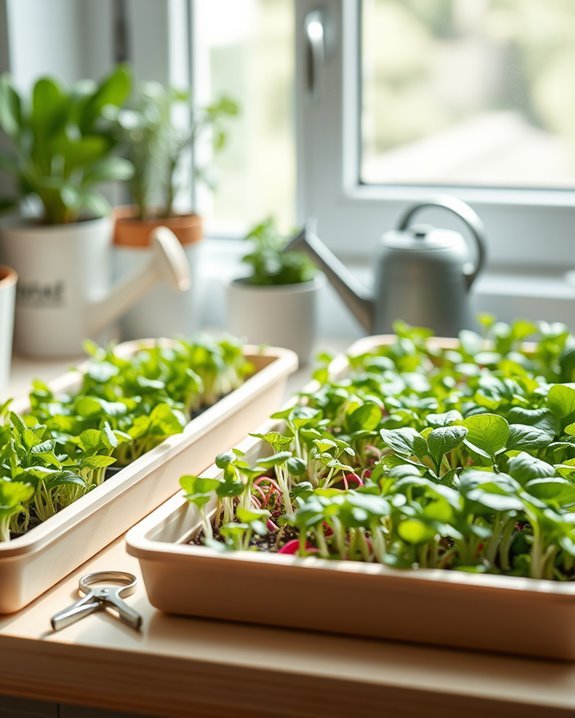
Growing microgreens is a fantastic way to enjoy fresh produce without waiting months for a full harvest.
You can choose from various microgreen varieties like arugula, radish, or basil.
Plant them in shallow trays and use simple harvesting techniques, like cutting just above the soil line when they reach 2-3 inches tall.
You’ll have vibrant greens ready to spice up your meals in no time!
Incorporate Edible Flowers

Adding edible flowers to your garden can elevate your culinary experience in a delightful way.
Consider planting flower types like nasturtiums, pansies, and marigolds. These not only add vibrant colors but also provide edible benefits.
You can use them in salads, desserts, or as garnishes, enhancing both flavor and presentation.
Enjoy the beauty and taste that edible flowers bring to your meals!
Create a Wildlife-Friendly Garden

Creating a wildlife-friendly garden not only benefits local ecosystems but also enriches your gardening experience.
By planting native species, you provide essential food and shelter for local wildlife, helping to establish thriving wildlife habitats.
Incorporate features like birdbaths, bee hotels, and diverse plant life to attract pollinators and other beneficial creatures.
You’ll enjoy a vibrant garden while supporting nature’s balance.
Use Garden Tools Efficiently

After you’ve established a wildlife-friendly garden, it’s time to focus on how to maintain it effectively.
Invest in multi-functional tools with ergonomic handles and safety features for comfort and security.
Prioritize tool selection and organization for efficient storage.
Implement maintenance practices that enhance tool longevity, and choose seasonal tools with user-friendly designs to make your gardening experience enjoyable and productive.
Take Advantage of Vertical Space

When you’re limited on ground space, maximizing vertical areas can transform your garden into a lush paradise.
Use vertical planters, wall gardens, and hanging baskets to create eye-catching displays. Incorporate trellis systems for climbing vegetables and design a vertical herb garden.
Space saving designs like plant shelves and garden ladders allow you to cultivate an outdoor vertical farm, maximizing every inch of your garden.
Grow Plants From Kitchen Scraps
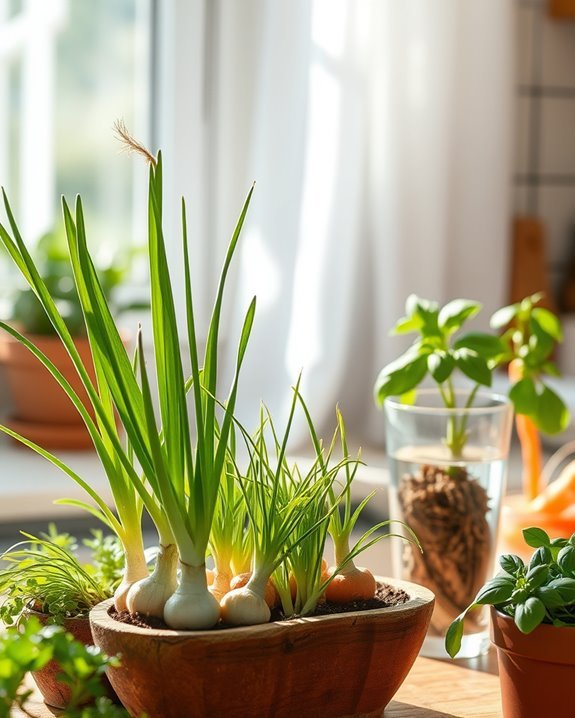
Maximizing your gardening potential doesn’t stop with vertical space; you can also utilize kitchen scraps to grow new plants.
For instance, simply place the white roots of scallions in water for quick regrowth. You can also plant potato eyes in soil to yield new potatoes.
These easy methods not only save money but also add freshness to your meals.
Explore Hydroponics or Aquaponics

Hydroponics and aquaponics offer innovative ways to grow plants without traditional soil, making them perfect for beginners enthusiastic to plunge into gardening.
With hydroponic systems, you can cultivate vibrant plants in nutrient-rich water, while aquaponic setups combine fish and plants for a symbiotic environment.
Both methods are space-efficient, require less water, and yield impressive results, making them exciting options for novice gardeners.
Build a Simple Greenhouse

If you’re looking to extend your gardening season or create a controlled environment for your plants, building a simple greenhouse is a fantastic project.
Use affordable greenhouse materials like PVC pipes and clear plastic sheeting for easy assembly.
This setup allows you to manage climate control effectively, keeping your plants warm and protected from harsh weather, ensuring a thriving garden year-round.
Learn About Seasonal Planting
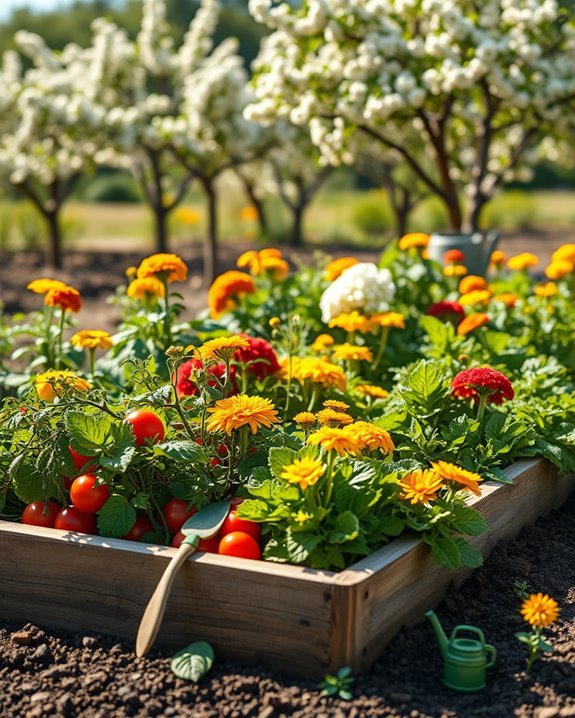
When’s the best time to plant your favorite vegetables and flowers? Understanding seasonal planting is key!
In spring planting, you can sow seeds for warm-weather crops like tomatoes and peppers.
For fall planting, think about cool-weather veggies like kale and carrots.
Timing your planting not only boosts growth but guarantees a bountiful harvest, making your gardening efforts more rewarding!
Use A Garden Planner App

After you’ve nailed down the best planting times for your favorite veggies and flowers, a garden planner app can take your gardening game to the next level.
These apps help you organize your garden layout, track growth, and remind you of key tasks.
With the app benefits like weather updates and pest alerts, you’ll boost your chances of a thriving garden effortlessly.
Experiment With Different Plant Varieties
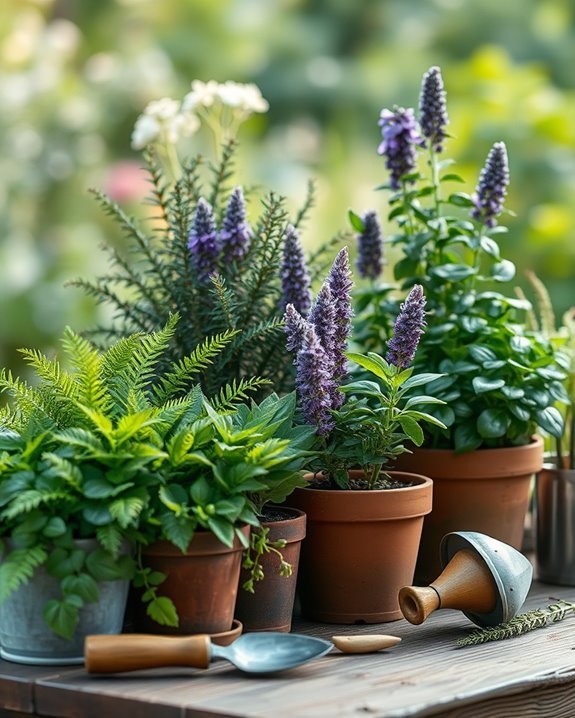
While exploring your gardening journey, experimenting with different plant varieties can be both exciting and rewarding.
Embrace plant diversity by trying out vegetables, flowers, and herbs you’ve never grown before. With careful variety selection, you’ll discover what thrives best in your environment.
This experimentation not only enhances your garden’s beauty but also boosts your gardening skills, making each season delightful.
Host a Garden Party or Swap

Hosting a garden party or swap is a fantastic way to celebrate your green thumb and connect with fellow gardening enthusiasts.
Consider inviting friends to share garden party ideas, like themed decorations or tasty treats.
For plant swap tips, encourage guests to bring their favorite cuttings or seedlings.
It’s a fun way to expand your garden and deepen friendships in the process!
Incorporate Shade-Loving Plants

If you have areas in your garden that receive little sunlight, incorporating shade-loving plants can transform those spaces into vibrant retreats.
Choose shade-tolerant flowers like astilbe and hostas for color, while adding ground cover options like creeping thyme or pachysandra to fill in gaps.
These plants thrive in low light, creating a lush, inviting atmosphere that enhances your garden’s beauty.
Monitor and Adjust Soil Ph

Creating a vibrant garden goes beyond just choosing the right plants; it also involves maintaining healthy soil.
Start with soil testing to determine its pH level, as different plants thrive in different pH ranges.
If your soil isn’t ideal, don’t worry! You can make pH adjustments using materials like lime or sulfur, ensuring your plants get the best environment to grow.
Stay Patient and Enjoy the Process

While gardening can be a rewarding journey, it often requires patience as you nurture your plants and watch them grow.
Embrace this patience practice, allowing yourself to learn and adapt along the way.
Cultivating gardening mindfulness helps you appreciate each stage of growth, making the experience enjoyable.
Conclusion
By diving into these beginner gardening ideas, you’re not just planting seeds; you’re cultivating a thriving paradise in your backyard! Remember, every great gardener started somewhere, so embrace the journey and watch your garden flourish like a scene from a fairy tale. Stay patient, keep experimenting, and most importantly, enjoy the process. Before you know it, you’ll be reaping the rewards of your labor and basking in the glory of your green thumb! Happy gardening!
